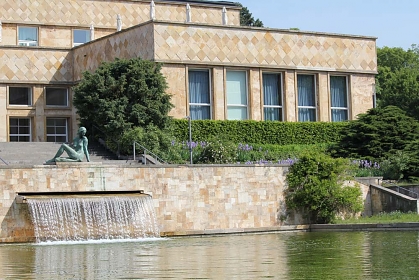In 2001 the former IG Farben Konzern properties became the Westend Campus of Frankfurt’s Goethe University, with the original IG Farben building housing the Humanities Department. Once the world’s largest chemical conglomerate, IG Farben was founded in 1925/26 through the amalgamation of the largest German chemical firms, which included Friedrich Bayer AG and BASF. In 1928 architect Hans Poelzig was commissioned to build the imposing
company headquarters, completing one of Europe’s largest and most modern office buildings in a mere two years.1 Poelzig designed a 250 m long main building in a gently arched layout. Six wings radiate from the nine-story building, with a laboratory complex adjoining to the east. The convex curvature and the skyward tapering windows minimize the monumentality of the building. The sole façade décor is provided by Cannstatt travertine marble, whose beige hues vary according to light exposure. Max Fromme, Frankfurt’s director of horticulture, designed the grounds. On the upward sloping parklands to the back he created a fountain display flanked by stairs and featuring Fritz Klimsch’s sculpture “By the Water.” The elongated pool creates an axial connection between the office complex and the casino building.
After 1933 all Jewish employees and directors, among them the brothers Arthur and Carl von Weinberg, Kurt Oppenheim, Max Warburg, Alfred Merton, Otto von Mendelssohn Bartholdy and Ernst von Simson were dismissed and persecuted.2 IG Farben’s pesticide Zyklon B was used to murder millions of Jews. Norbert Wollheim, who bore the prisoner number 107984, was interned in the Buna/Monowitz concentration camp, where 40,000 slave laborers lost their lives. In 1951 he successfully brought a test case before the Frankfurt district court, and in 1957 the chemical concern had to pay 30 million Deutsche marks in punitive damages.3 Artist Heiner Blum’s “Wollheim Memorial,” which is located in the former gatehouse and contains video interviews with contemporary witnesses documenting the fate of the prisoners, is named for him. Photo panels in the park further illustrate the lives of the slave laborers.
Universitätscampus Westend
- Kalusche, Bernd; Setzepfandt, Wolf-Christian (2002): Frankfurt am Main Architekturführer. Berlin: D. Reimer, S. 45.
- Giersch, Thorsten (2011): Geschichte der IG Farben. Der Konzern, der Hitler den Weltkrieg ermöglichte. Accessible online at http://www.handelsblatt.com/unternehmen/industrie/der-konzern-der-hitler-den-weltkrieg-ermoeglichte/4428986.html . Zuletzt geprüft am 30.11.2011.
- Drummer und Zwilling 2007, S. 88.



